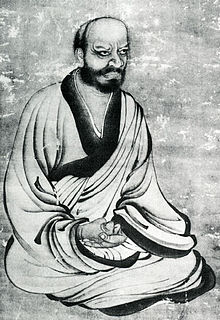Linji Yixuan
| Linji Yixuan | |
|---|---|

Japanese painting of Linji Yixuan (Jap. Rinzai Gigen).
|
|
| School | Ch'an |
| Personal | |
| Born | unknown China |
| Died | 866 CE |
| Senior posting | |
| Title | Ch'an Master |
| Religious career | |
| Teacher | Huangbo Xiyun |
Linji Yixuan (simplified Chinese: 临济义玄; traditional Chinese: 臨濟義玄; pinyin: Línjì Yìxuán; Wade–Giles: Lin-chi I-hsüan; Japanese: 臨済義玄 Rinzai Gigen; died 866 CE) was the founder of the Linji school of Chán Buddhism during Tang Dynasty China.
Information on Linji is based on the Línjì yǔlù (臨濟語錄; Japanese: Rinzai-goroku), the Record of Linji. The standard form of these sayings was not completed until 250 years after Linji's death and likely reflect the teaching of Chán in the Linji school at the beginning of the Song Dynasty rather than those of Linji's in particular.
This contains stories of his interactions with teachers, contemporaries, and students. The recorded lectures are a mixture of the conventional and the iconoclastic. Despite the iconoclasm, the Línjì yǔlù reflects a thorough knowledge of the sutras. Linji's teaching-style, as recorded in the Línjì yǔlù, was exemplary of the development Chán took in the Hongzhou school (洪州宗) of Mazu and his successors, such as Huangbo, Linji's master.
According to the Línjì yǔlù, Linji was born into a family named Xing (邢) in Caozhou (modern Heze in Shandong), which he left at a young age to study Buddhism in many places.
Also according to the Línjì yǔlù, Linji was trained by the Chan master Huángbò Xīyùn (黃蘗希運), but attained kensho while discussing Huángbò's teaching during a conversation with the reclusive monk Dàyú (大愚). Linji then returned to Huángbò to continue his training after awakening. In 851 CE, Linji moved to the Linji temple in Hebei, where he took his name, which also became the name for the lineage of his form of Chán Buddhism.
...
Wikipedia
